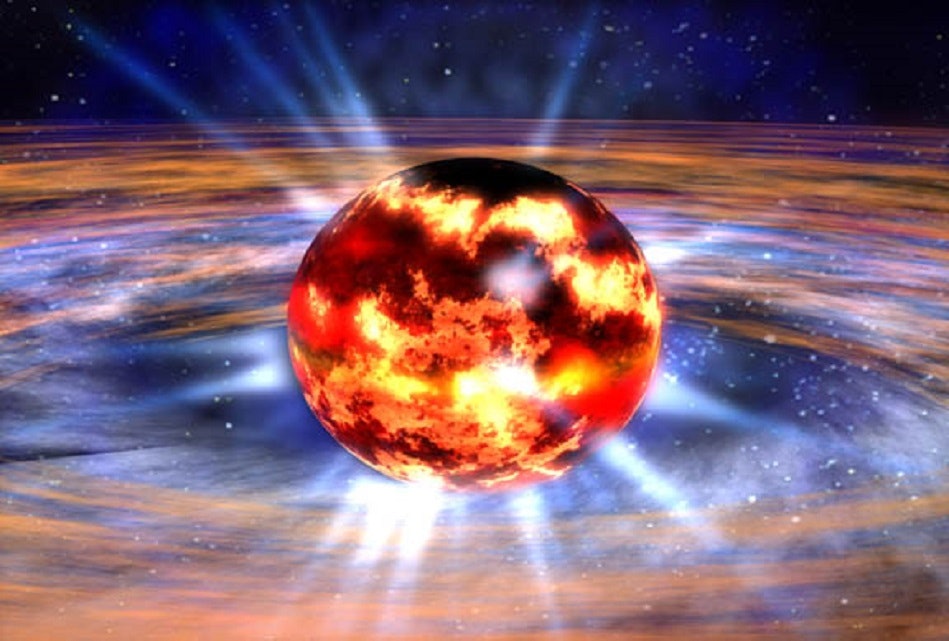IN THE MIDDLE of the glowing gas cloud of a supernova remnant, about 8,000 light years away, sits the crushed heart of a dead star.
Astronomers recently discovered that this neutron star left behind by the collapse and explosion of a supergiant is now roughly 77 percent the mass of our Sun, packed into a sphere about 10 kilometers wide. That’s a mind-bogglingly dense ball of matter — it’s squished together so tightly that it doesn’t even have room to be atoms, just neutrons. But as neutron stars go, it’s weirdly lightweight. Figuring out why that’s the case could reveal fascinating new details about exactly what happens when massive stars collapse and explode.
WHAT’S NEW — When a massive star collapses, it triggers an explosion that blasts most of the star’s outer layers out into space, where they form an ever-widening cloud of hot, glowing gas. The heart of the star, however, gets squashed together in the final pressure of that collapse and becomes a neutron star. Normally, what’s left behind is something between 1.17 and 2.35 times as massive as the Sun, crammed into a ball a few dozen kilometers wide.

Based on math and computer simulations, physicists generally think that a neutron star has to be at least 1.17 solar masses to actually work. The smallest one ever found is called PSRF0453+1559 (astronomical names are so gorgeously poetic) and it weighs in at around 1.174 times the mass of our Sun, right on the edge of the predicted limit.
So the weirdly light neutron star at the heart of supernova remnant HESS J1731-347 came as a surprise to University of Tuebingen astrophysicist Victor Doroshenko and his colleagues, who recently calculated its mass and radius.
The neutron star has received a lot of attention because it’s among the brightest neutron stars in the sky — in X-rays, which our eyes can’t see but telescopes like XMM-Newton can. But Doroshenko and his colleagues recently spotted a second star, one that’s still shining in wavelengths of light our eyes can see, inside the expanding debris cloud from the supernova. It’s hard to measure the distance to a neutron star, but the newfound visible star gave the astrophysicists a cosmic landmark.
And once they knew how far away the neutron star was, they could also calculate its mass and radius.
“Our estimate implies that this object is either the lightest neutron star known, or a ‘strange star’ with a more exotic equation of state,” write Doroshenko and his colleagues in their paper in the journal Nature Astronomy.
WHY IT MATTERS — The existence of a neutron star like this one means that physicists now have to explain how it happened, which means they’re going to rethink a bit of what they know about how supernovae forge the small, dense balls of neutrons they leave in their wake.
That’s going to take detailed computer simulations, a lot of math, and probably more data from telescopes like XMM-Newton and NICER to really unravel the details, but Doroshenko suspects the answer has something to do with how much material the supernova strips away from the core of the star.
“The basic idea would be that a somewhat larger fraction of the progenitor’s mass than usual needs to be removed from the core during the explosion,” Doroshenko tells Inverse. In other words, explaining this weird neutron star will teach us a lot about what happens to the core of a dying star just after it collapses.
One clue might come from the other star — the visible one — lingering in the middle of the cosmic debris cloud of JESS J1731-347. The star appears to be “a core of a giant star which lost most of its outer layers,” Doroshenko says. That happens to stars sometimes in the very late stages of their lives, and it would have made the neighborhood around the star and its neighbor very dusty. When the supernova exploded, all that stardust could have affected the physics of the explosion, in a way that caused the collapsed core of the dying star to lose more of its mass than usual.
“Those are all just my naive speculations, and detailed modeling of the explosion would be needed to answer if it has any connection to reality,” says Doroshenko.
But there’s an even weirder possibility: a strange star — that’s its proper scientific name, not just a colorful description — made of quarks.
HERE’S THE BACKGROUND — Technically, everything (except for electrons) is made of quarks. Quarks are the tiniest, most fundamental bits of matter, and they combine to make up neutrons and protons. Protons and neutrons (and electrons) assemble into atoms, and we usually think of atoms as the building blocks of matter. But when a star collapses — which is what happens in the instants before the explosive part of a supernova — things get complicated.
When the core of a massive star collapses under its own gravity, the tremendous pressure squashes the dying star’s atoms together so hard that protons and electrons merge into neutrons. All those neutrons are pressed so closely together that there’s not room to arrange themselves into any kind of structure — for instance, a bunch of atomic nuclei. Imagine being at a party so crowded that there’s no room for smaller groups to clump together, and everyone’s just jammed into the room, shoulder to shoulder, with just enough room to awkwardly shift their weight once in a while. That’s a neutron star, more or less.
Now imagine even more pressure squeezing the already squashed-together ball of neutrons (it’s probably a good idea to stop imagining a metaphorical party at this point). That might happen because the dying star’s core is so massive and so dense that it keeps collapsing, even once all the atoms have been squashed into neutrons. And this is where things get weird, and where theoretical physics gets very theoretical.
Neutrons are made of even smaller particles called quarks, so under that tremendous pressure, the neutrons split apart into quarks. If you ask a theoretical astrophysicist what happens next, they’ll probably tell you that those squashed quarks are extremely short-lived, because the whole mass just keeps collapsing until it becomes a black hole. But what if it doesn’t?
According to a couple of Soviet physicists in the mid-1960s, a collapsing star might be too massive to end up as a neutron star, but not quite massive enough to make it all the way to a black hole. Instead, the star might get stuck in between, as a ball of quarks. A quark star — or strange star, after the particular type of quark involved — is born.
“My personal point of view is that there is probably no such a thing as a pure quark star,” says Doroshenko. “This does not mean that there is no quark core under some conditions, and that’s actually factored in in some of the neutron star equations of state currently considered.”
And according to Doroshenko and his colleagues, the small neutron star could technically be a quark star, or at least a neutron star with a quark core.
DIGGING INTO THE DETAILS — So far, physicists haven’t actually found a quark star, or strange star, in the universe, although they’ve spotted a handful of things that might turn out to be strange stars. There’s still a lot of debate about whether a strange star could actually be stable enough to exist.
Most models predict that if a strange star existed, it would probably be denser than a neutron star — about the same mass, but packed into a smaller area. And that’s what makes the neutron star at the center of supernova remnant HESS J1731-347 so interesting.
“For ordinary neutron stars, such a light object would be expected to have a somewhat larger radius,” says Doroshenko.
In other words, it’s small for a neutron star, but that small mass is packed into an even smaller ball of matter, so the result is something lighter but also denser than a neutron star “should” be, which is a decent description of what you’d look for if you were looking for a strange star.
“I do not think that one can call this object a quark star, but it may have a quark core,” says Doroshenko. “And that’s arguably even more interesting as it allows us to learn more about “ordinary” neutron stars which are definitively there and which are very important both for understanding stellar evolution and as laboratories for extreme physics to be explored with missions like Strobe-X or eXTP.”
On the other hand, Doroshenko is quick to point out that the neutron star could be just an unusually small neutron star.
“I emphasize, however, that deduced mass and radius are still fully consistent with many neutron star equations of state, i.e. it can well be a neutron star even if a bit extreme (and thus interesting),” he says.
How will astronomers eventually unravel what this lightweight neutron star is made of? Lots more data.





